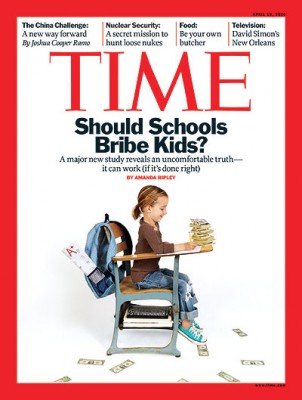
Time Magazine Cover (April 19, 2010 Issue)
The current issue of Time magazine features a cover story entitled “Should Schools Bribe Kids?” Amanda Ripley reports on a contentious study by a Harvard professor about how incentives influence student performance — but with a twist. Instead of paying teachers more for improved student performance, the idea in this study was to pay students for anything from showing up to school on time and wearing the proper uniform to behaving well in class and acing standardized tests.
The study was led by Harvard economist Roland Fryer, Jr., a scholar who shot to fame two years ago by becoming the youngest African American ever tenured by Harvard (at age 30). Fryer’s groundbreaking work into the black-white achievement gap and the phenomenon of “acting white” gained a national audience when it was reported on in the 2005 bestseller Freakonomics: A Rogue Economist Explores the Hidden Side of Everything.
(On a side note, I find it troubling that Time chose to feature a white girl on its cover when the story itself is about African-American and Latino students from low-income families. In fact, the five photos of students that accompany the story have only African-American faces. So why not an African-American student on the cover?)
What’s interesting about the study are the very mixed results. Experiments ran in four cities — Chicago, Dallas, New York City and Washington, D.C. — but only the Dallas and Washington, D.C. experiments seem to have “worked” in that important student outcomes improved.
The Dallas experiment was by far the cheapest and most basic, as well as the most successful. In it, second-graders from 22 different schools were paid $2 for each book they read. Students who received this money had significantly stronger reading comprehension scores when tested later in the year than students in a control group who received no such incentive. Ripley reports that “the experiment had as big or bigger an effect on learning as many other reforms that have been tested, like lowering class size or enrolling kids in Head Start early-education programs (both of which cost thousands of dollars more per student). And the experiment also boosted kids’ grades.”
I’m partial to the Dallas experiment because I used to do a very similar thing when I taught middle school. To make it seem less like I was bribing my students, however, I would give out lottery tickets for quarterly drawings. Students could earn lottery tickets by doing well on tests, helping out in the classroom, being a good Samaritan, and reading books, among other things. The vast majority of the lottery tickets I gave out went to students who read books in their free time, and so those who won the prizes — candy, gift certificates to the local mall, framed photographs and even books — tended to be the voracious readers in my classroom. I required students to fill out a form on each book they read and have a parent sign off on the fact that the student had actually read the book. Some of my students would read 200 books a year! (And, yes, I did have guidelines about what counted and what didn’t. Books had to be at least 75 pages long and of an appropriate reading level for the student.)
I found this a cost-effective way to promote reading and good behavior in my classroom, though of course I was paying for the prizes out of my own pocket. Fryer’s experiment, by contrast, was funded largely by private donations to the tune of $6.3 million. (If you do the math, that’s $350 per child for the 18,000 students in the study — not exactly cheap for something that appears not to have made much difference in two of the four experiments.)
To be sustainable, any future program that would seek to motivate students with money shouldn’t rely on private funders. Though the idea of giving hard, cold cash to students is anathema to many — it’s nothing short of bribery, critics claim — Fryer’s study suggests it might well be a cost-effective way to encourage positive behaviors, especially among elementary students.



